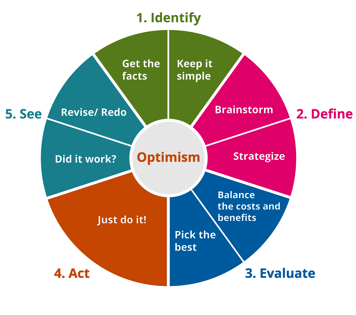Modules 1 to 5 covered many skills and strategies for helping your teen manage their sickle cell pain. Below is a summary of the skills and strategies from each module.
Module 1: Introduction
In Module 1, you learned about:
- the iCanCope with Sickle Cell Pain program
- different ways to help support your teen in managing their sickle cell pain
- developing SMART goals.
3P approach to pain management

Pain is best treated with:
- psychological strategies, or methods
- physical strategies
- pharmacological strategies
Together, these form the 3P approach to pain management.
SMART goals
Effective goals are SMART goals. This means they are:
- specific (clearly defined)
- measurable (you can measure when you have reached the goal)
- achievable (possible to reach)
- relevant (important to you)
- time-bound (there is a deadline or an end date)
Module 2: Behaviour skills
In this module, you learned to:
- respond to your teen's pain
- reinforce positive pain coping skills
- encourage your teen's independence
Key points about behaviour
- Behaviours followed by positive outcomes are strengthened, but behaviours followed by negative outcomes are weakened.
- When your teen's behaviour leads to satisfying or rewarding outcomes, they are more likely to repeat this behaviour. We call rewarding outcomes "reinforcers" because they reinforce or strengthen a behaviour. Attention is a powerful reinforcer.
- To encourage independence, think about what specific tasks you want your teen to manage on their own. Then, consider the skills they may need to develop to meet these goals and how you can support them to develop these skills.
Modules 3 and 4: Problem solving

In these modules, you learned about:
- the Bright IDEAS system for problem solving
- positive and negative approaches to problem solving
- how emotions can affect problem solving
- how to get a more positive outlook by using positive self-statements
Bright IDEAS system for problem solving
The aim of the Bright IDEAS system of skills is to increase your ability to solve some of the trickier problems or concerns you may face as a parent or caregiver of a teen with sickle cell disease. You can apply the skills you learn to sickle cell–related challenges or many other issues.
Almost any problem, no matter how big it may appear at first, can be solved if you break it down into small parts or steps. Each step can then be solved, one at a time.
The steps can be remembered using the word IDEAS.
- I Identify the problem
- D Define your options
- E Evaluate your options
- A Act out your choice
- S See if it worked

Module 5: Communication

In this module, you learned:
- strategies that can help you talk with your teen
- strategies that can help your teen feel listened to
- strategies that can help you communicate with health-care providers, teachers and other school staff
Strategies for talking with your teen
Be a good communicator
- Be direct.
- Include your perspective and feelings.
- Plan what to say.
Be a good listener
- Be accessible.
- Be present.
- Use questions sparingly.
Keep it positive
- Show physical affection.
- Comment on the positives.
- Have family meetings.
- Give straightforward advice.
- Reduce negativity in your home.
Your strategies
As you can see, you have learned different behaviour management and communication strategies and skills over the past weeks that you may want to continue using if you need them in the future.
Which of the strategies do you think were helpful for you and your family?